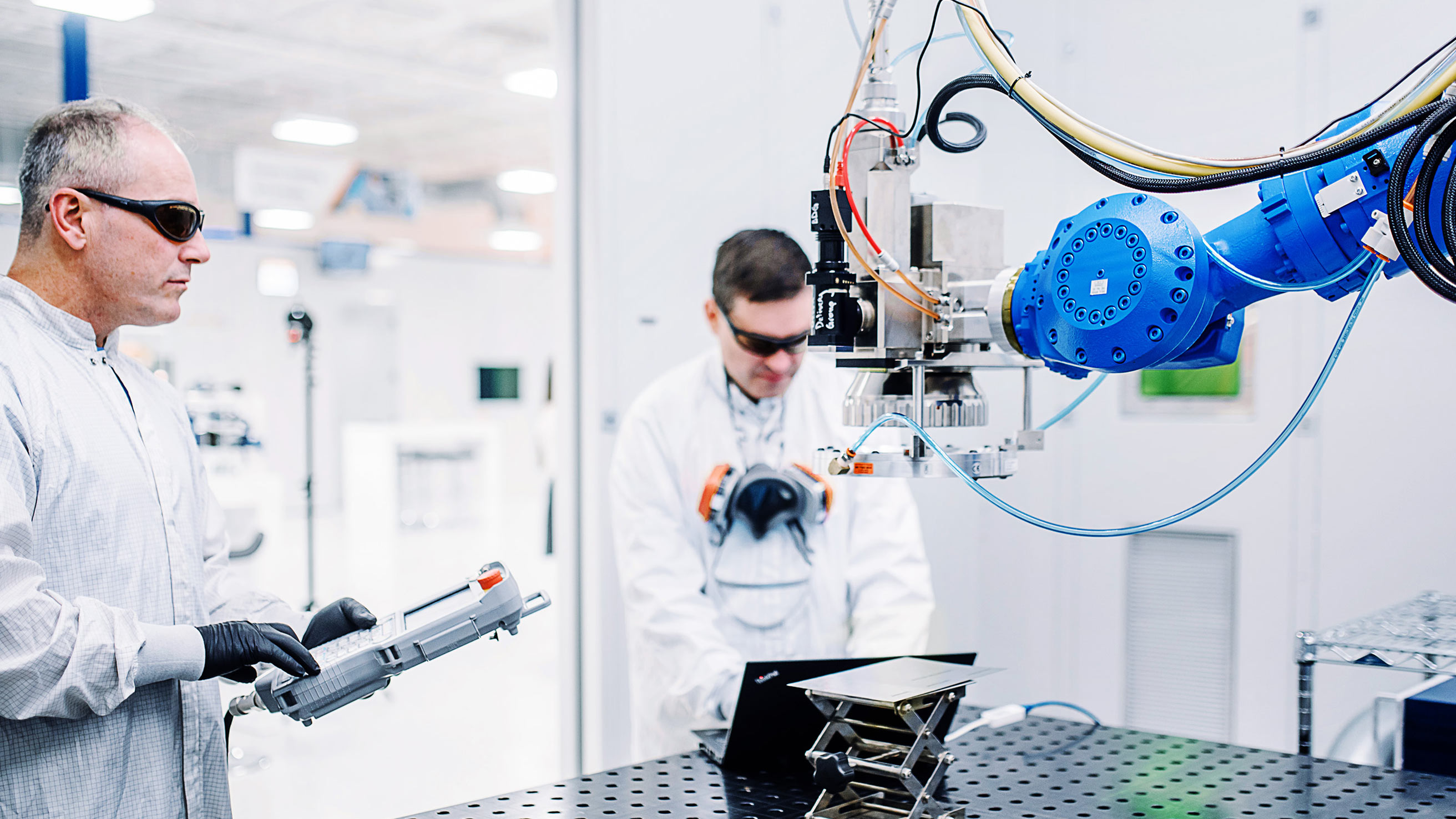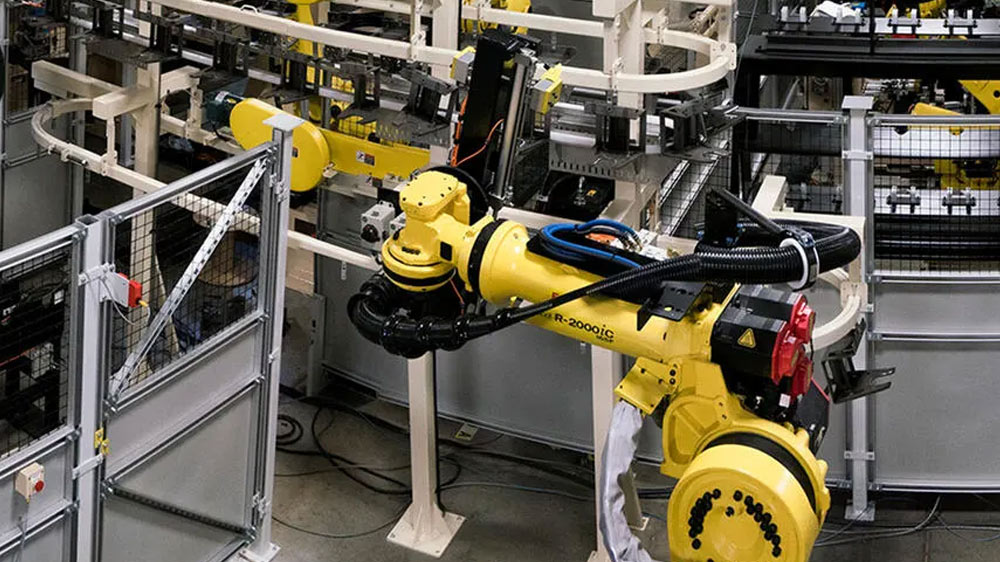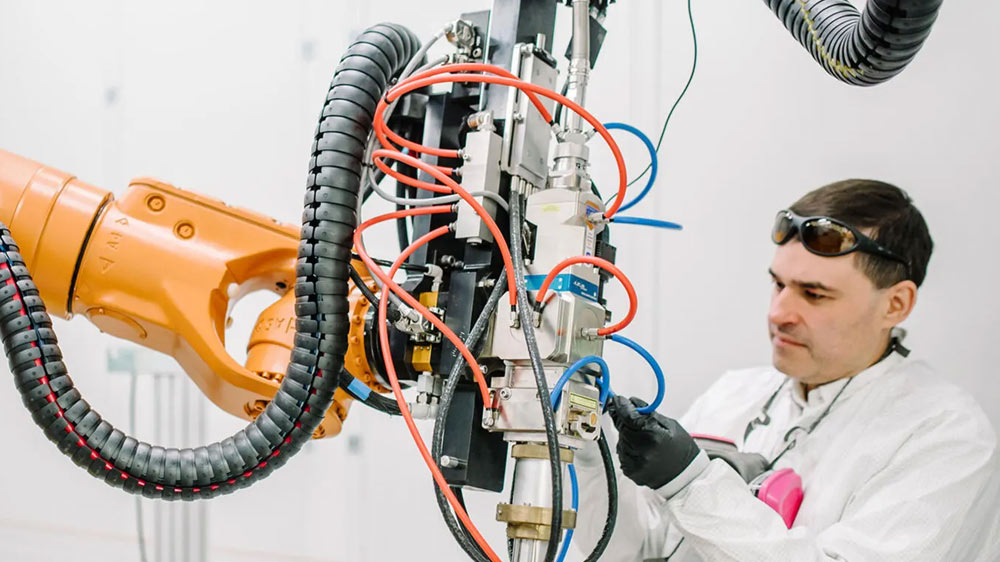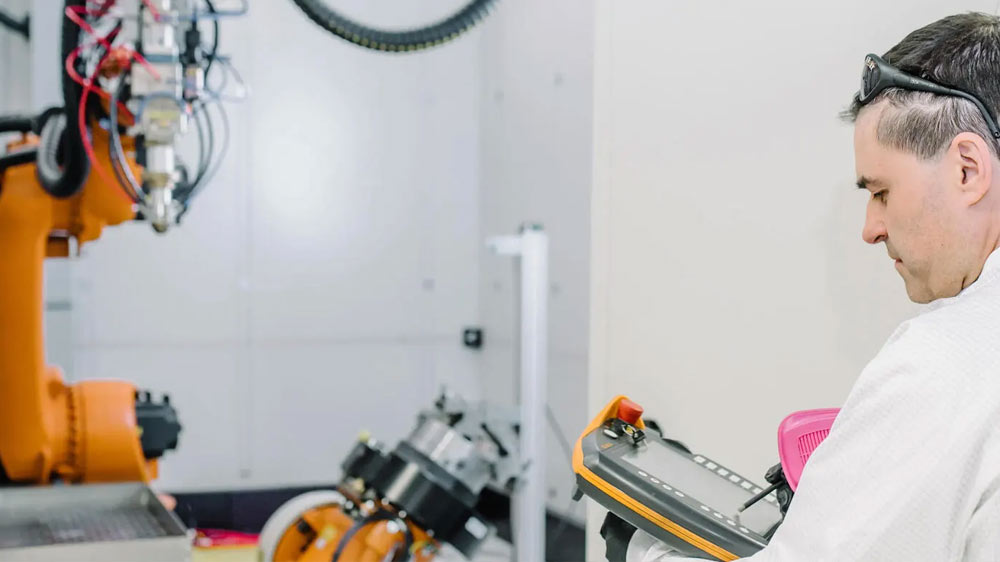Whether launching a new product or scaling up production on an existing one, manufacturers are under intense pressure to automate faster, more reliably, and with less risk. Time-to-market becomes a key metric that directly impacts profitability, competitiveness, and customer satisfaction. Every delay means lost revenue, missed opportunities, and higher costs.
For both integrators and manufacturers, building an automated production system usually involves sourcing various components – like lasers, robotics, controllers, and tooling – from multiple vendors. This fragmented method introduces complexity, delays, and risk. When problems arise, finger-pointing between suppliers can cause critical bottlenecks, extending launch timelines and driving up costs.
Offering industries a better path forward for laser automation has been one of our focuses at IPG Photonics. As a complete automation system supplier, IPG partners with manufacturers, working with their production teams to design, build, install, and maintain a fully integrated production solution. We have found that, with just one vendor responsible for every part of the solution, manufacturers can ramp up faster, eliminate surprises, and rely on a single resource for support.
In this article, we’ll discuss the benefits of working with a comprehensive laser automation solution provider – particularly how the right partner can help you minimize risk and build a stronger foundation for long-term success.
The Traditional Route to Automation
Manufacturers typically rely on one of two strategies to implement a custom automation system: they build it themselves or they hire a system integrator. While both approaches can work, they often carry hidden risks – especially for laser-based processes – that affect time-to-market, cost, and overall system performance.
For some, sourcing individual building blocks from various vendors may seem like a more flexible or cost-effective approach. But all too often the actual cost of piecemeal integration far outweighs any savings at the outset.
When components come from different suppliers, the burden of making them work together falls squarely on the end user. This creates risk at every stage: mismatched interfaces, unproven process compatibility, unclear accountability, and extended system debug times. Each integration gap introduces opportunities for delays, unexpected engineering hours, and added cost.
The biggest difficulty often comes after installation has begun. With multiple vendors involved, diagnosing and fixing problems can turn into a blame game, with each supplier pointing to someone else’s component as the cause. Meanwhile, production timelines slip, internal resources get tied up, and costs climb. By the time a piecemeal system is fully operational, manufacturers often realize they’ve spent far more – in time, money, and frustration – than they would have by sourcing a fully integrated solution from the start.
System integrators aim to solve this problem. But most have one significant limitation. While they are experts in robotics, controls, and systems engineering, few have deep in-house expertise in laser-material interaction, laser process optimization, or optical system design. As a result, working with an integrator often involves layers of subcontracting and divided technical ownership. If a problem arises, resolving it can require weeks of back-and-forth between the integrator and their own suppliers.
The Single-Source Approach
How does IPG solve these problems? Aren’t we just another integrator or component provider on the list?
Most people reading this are already familiar with IPG Photonics as a pioneer and market leader in industrial fiber lasers. But many might not know that IPG has grown to become much more than just a laser manufacturer.
Today, we possess all the expertise and resources required to deliver a true single-source solution to automation. Of course we provide lasers; but we also integrate optics, robotic systems, motion platforms, tooling, control systems, vision solutions, and even safety enclosures – all engineered to work together seamlessly. From standalone workstations to complete, automated manufacturing lines for high-volume production, every element of the system is built on our deep expertise in laser/material interaction and industrial automation. There’s no divided responsibility, no subcontractor layers, and no uncertainty about system performance.
And our capabilities extend far beyond hardware. We engage early in the project lifecycle, working with customers to develop the right laser process through applications development, feasibility studies, and virtual simulations. Then, we design, build, and validate the system in-house to minimize any surprises during installation. Once deployed, we provide support, operator training, and 24/7 service. Users of IPG automation systems only have a single point of contact from start to finish – and beyond.
Here’s what we have found: our customers get a faster, smoother path to production with far less risk. IPG takes responsibility for the automation system itself, freeing manufacturers to focus on ramping up production, not troubleshooting problems.
Understanding how it all works, from laser-material interaction to designing tooling and even parts optimized for laser processing, can be daunting. Let’s look at some of the resources we offer for automation system development to better paint the picture.
Applications Development: The Foundation for Success
The difference between IPG and other integrators becomes clear right at the outset. We begin by studying, testing, and characterizing the laser process itself. This is critical because achieving reliable production results requires a proven, well-optimized process developed under real-world conditions.
This effort is led by our Applications team working out of global application labs. Laser scientists and application engineers work with manufacturers to develop fully validated processes tailored to each application. Whether it’s welding, cleaning, texturing, cutting, or additive manufacturing, our team’s goal is to ensure outcomes are optimized long before the system build begins.
This collaboration at the earliest stage dramatically reduces downstream risk because it enables us to construct a system based on a tested, optimized foundation. This is key to ensuring a seamless transition from prototype to production.
Advanced Tools to De-risk Automation
This same rigorous, analytical mindset is next applied to developing the full automation system. One of the most valuable tools we use here is virtualization.
Historically, automation system builders have relied on a laborious and costly “concurrent engineering” cycle. This involves building physical prototypes and then testing them to validate the design or reveal unexpected issues. This process is iterated until the system is satisfactorily proven and reaches its final form. While effective, this traditional method adds significant time, cost, and risk to every launch.
Today, IPG leverages advanced virtual manufacturing tools to dramatically shorten and streamline the concurrent engineering cycle. By simulating, analyzing, and optimizing automation systems digitally, we identify and eliminate risks before they even reach the prototype stage. Two of the most valuable tools we employ in this effort are Variation Simulation Analysis (VSA) and Weld Distortion Analysis (WDA).
With VSA, IPG can model and simulate literally thousands of “digital builds” of a part or assembly. Virtually every aspect of the process is included in this simulation. For example, VSA incorporates 3-D models of the parts and assemblies, as well as the tools, work-holding devices, and any other ancillary mechanical components present in the system. Finite element analysis is employed to model the strength and durability of all these mechanical parts. Robotic simulation is used to model the real-world motion of physical robots.
VSA shows us how natural variations in component tolerances affect key features of the manufactured assemblies. The software analyzes the performance of tooling and work-holding devices to predict the statistical variation of critical dimensional features in the final parts. This provides a powerful means to reduce the time and cost needed to optimize the product and tooling.
WDA goes a step further, simulating the effects of welding processes on part geometry. By modeling material properties, heat-affected zones, weld sequences, and fixturing, WDA predicts where distortion is likely to occur. Then, it suggests changes to the process flow, tooling, or part design to mitigate any issues. The results are better welds – with minimal distortion, low residual stress, and maximum strength – without having to perform numerous testing cycles on actual parts.
IPG Delivers a Range of Automation Solutions
What does an automated system from IPG look like?
Every manufacturing challenge is different. Some manufacturers want to build from a standardized solution to get a new laser process online right away. Others require an individually engineered, fully customized system built from the ground up for a specific, high-volume production environment. IPG offers solutions at both these endpoints, as well as anywhere on the spectrum in between. We work with each customer to determine the right path based on their goals, timelines, and budgets.
Some applications can use an augmented version of one of our preconfigured products, like our LaserCell 2000. These standalone work cells come fully integrated with IPG lasers, optics, motion systems, and safety enclosures. They are ideal for operations that need a proven, efficient solution without the time and cost of a custom design.
Building up from a standard system minimizes engineering effort and shortens time-to-production significantly. These tools can readily be customized with a variety of part loading/unloading and handling options, robotics, vision systems, and more. This enables them to integrate seamlessly into an existing production line or optimize their ability to perform a specific task.
When the application demands something more unique, we design and build custom automated systems. These can incorporate a wide range of elements, such as vision systems, specialized tooling, advanced robotics, part handling, PLCs, and communications interfaces, and range from a single, standalone workstation through high-volume, multi-station systems.
These systems are tailored specifically to the process, material, production rate, and quality requirements of the customer. While more expensive and time consuming to develop, a custom solution can deliver maximum performance and ROI.
Whether you choose to build on one of our standard systems or have us create a fully custom automated production line, you’ll benefit from single-point accountability and our proven ability to deliver on time and on budget. When you partner with IPG, you also gain access to our global service and support network, including expert installation, hands-on training, and ongoing technical assistance to keep your system running at peak performance.
Applications: Welding and Beyond
What applications can use IPG automated laser solutions?
Welding is still our most common application, although the range and variety of welding tasks we service has expanded greatly over the past few years. For example, in the automotive sector, laser welding has become a critical tool for supporting lightweighting initiatives and the increasing use of high-strength steel alloys. As a result, IPG systems are used for welding panels, door rings, body-in-white substructures, gears, seat frames, and more, delivering strong, precise joints with minimal heat distortion.
E-mobility manufacturing has become another significant segment of automotive manufacturing over the past few years. These tasks frequently involve different materials, assembly techniques, and higher levels of precision than other areas of automotive production. As a result, they pose challenges for production welding systems to simultaneously deliver exceptional weld quality and high throughput. Developing automated laser tools that reach these goals is significantly facilitated using our virtualization tools. These enable us to reduce development time and still deliver superior results.
But we also support a wider range of manufacturing processes beyond just welding. Our deep expertise in laser-material interaction enables us to tackle applications ranging from cleaning, texturing, cutting, and heating/drying, through additive manufacturing.
For example, IPG laser automation enables efficient surface cleaning that can replace mechanical brushing or chemical treatments, surface texturing for adhesion and appearance improvements, and precision cutting of metals and composites. These non-contact laser processes improve quality, reduce maintenance, and increase throughput, all while integrating smoothly into automated production environments.
Whether it’s joining lightweight alloys, preparing surfaces for bonding, or cutting complex shapes, IPG automation solutions bring the benefits of laser processing into new applications, helping manufacturers to streamline their operations and improve product performance.
Smarter Automation for a More Complex World
Manufacturing processes today are more complex and challenging than ever before. Materials are changing. Part geometries are becoming more complex. Production volumes are rising while tolerance windows shrink.
In this environment, following the traditional paths to automation – whether it’s building a system yourself or relying on general-purpose integrators – may fails to deliver the speed, precision, or reliability manufacturers need to stay competitive.
Modern laser-based production methods demand a smarter approach. One grounded in deep process knowledge, extensive automation expertise, and comprehensive system engineering capabilities. Our goal is to offer our customers these core competencies to both empower them and continue to advance the state of manufacturing.
Getting Started with Laser Automation
Interested in learning how an automated IPG laser solution can benefit your operation?
Getting started is easy – send us some sample parts, visit one of our global application labs, or just tell us about your application.




